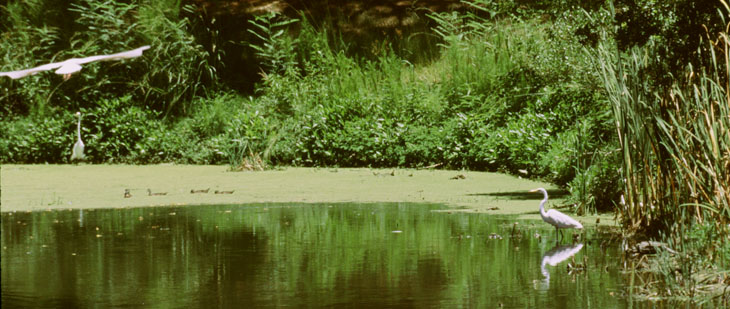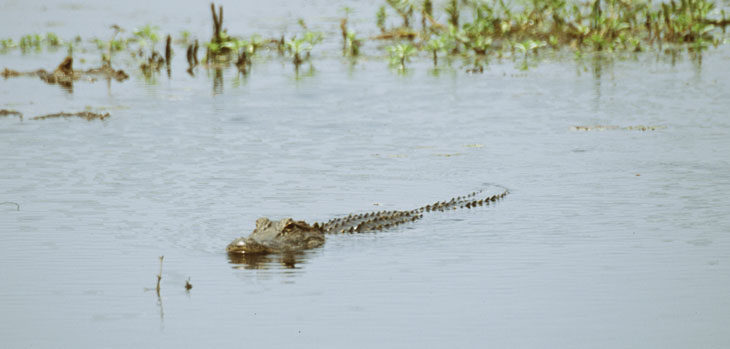
On this recent trip, we actually got into three different wildlife refuges, although none of them at an optimum time (and all of them in South Carolina.) Nevertheless, we managed plenty of sightings and a few photographs here and there. I am, for some unknown reason, having a hell of a time getting the slide scanner to lock onto the colors, so these images are less impressive than they should be, and I apologize.
On the drive down, we stopped at Santee National Wildlife Refuge on Lake Marion near Summerton, SC. This has easy access off Interstate 95 and is well-marked. We were there at midday, not the best of times, and the heat seemed to have kept many critters less active. I was on the lookout for water moccasins, something I have yet to capture on film in the wild, but we saw only a few lizards, deer, and a raccoon that scampered off before I could retrieve the camera from the bag. I have no doubts that there would be lots more to see, judging from the area and their visitor’s center, but we were on the outward leg of our journey and not going to tarry long.
A few days later, we checked out Savannah National Wildlife Refuge, which is actually just over the border into South Carolina from Savannah. Many of the trails and the vehicle drive were closed due to maintenance, so we saw only a tiny fraction of the area, and were delayed getting out of the house on both days we visited, so again, not there at optimum times. Despite the fact that we were only accessing the walking trail (between sections 7 and 8) and kept that to a minimum because of the heat, both times we were greeted by American alligators (Alligator mississippiensis) almost as soon as we got out of the car – quite literally on the second day. Seen at the top of this post, one gator turned and headed straight for where we stood, plainly obvious on the bank – there is no doubt in my mind that people have been feeding them. It halted before it reached my “return to the car” line, apparently because we weren’t actually exhibiting any signs of offering food. I make it a point to maintain safe distances and practices with wildlife, knowing all too well that they can be provoked into protective or territorial behavior by cues we’re not familiar with. Someone might have an impression of the “intrepid” nature photographer braving danger to get that really cool shot, but that’s a stupid nature photographer, and needs not be encouraged. If you’re that close, you’re not only putting yourself at risk for a mere photo, but interrupting the natural behavior of the animals and providing a bad example for others. People often consider nature photographers to be naturalists in their own right, knowledgeable about habits and behavior of their subjects and thus a good person to emulate, but owning a camera with a long lens does not grant automatically this knowledge.
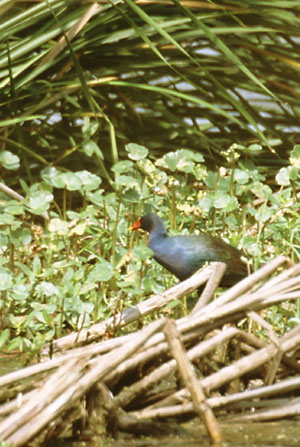 The most common subjects we saw in this refuge were the purple gallinules (Porphyrio martinica,) where the males displayed rich, iridescent blue/purple coloring, but the females a very drab black. About the size of bantam chickens, we had arrived at fledgling time, and numerous mothers were out with their chicks showing them how to forage for food. Most areas of the walking path were shrouded from the adjoining channel by tall cattail reeds, and it often required shooting through a screen of them. The gallinules frequently called to one another, as well as maintaining quieter clucks to keep the chicks oriented with their mother. The Girlfriend and I had witnessed the same thing in the NC mountains with the wild turkeys there; the mothers provide a near constant series of quiet, muttering calls which don’t carry very far, which the chicks know to keep within earshot. These calls are faint enough to avoid attracting attention from greater than 15 meters (50 feet) or so. If the chicks stray beyond hearing range, they frantically start a louder call to try and find mama.
The most common subjects we saw in this refuge were the purple gallinules (Porphyrio martinica,) where the males displayed rich, iridescent blue/purple coloring, but the females a very drab black. About the size of bantam chickens, we had arrived at fledgling time, and numerous mothers were out with their chicks showing them how to forage for food. Most areas of the walking path were shrouded from the adjoining channel by tall cattail reeds, and it often required shooting through a screen of them. The gallinules frequently called to one another, as well as maintaining quieter clucks to keep the chicks oriented with their mother. The Girlfriend and I had witnessed the same thing in the NC mountains with the wild turkeys there; the mothers provide a near constant series of quiet, muttering calls which don’t carry very far, which the chicks know to keep within earshot. These calls are faint enough to avoid attracting attention from greater than 15 meters (50 feet) or so. If the chicks stray beyond hearing range, they frantically start a louder call to try and find mama.
The screening cattails meant that we only saw birds on the opposite side of the channel, though the soft (and sometimes loud) calls told us we were often only a few meters away from ones on our side of the channel, but totally unable to see them. It is frustrating to know you’re close enough for much better images, if only you could see through the foliage. A kayak would have provided a view of both sides, though it’s unlikely the presence of such a vessel would be ignored. I have never lived close enough to a good location to construct a floating blind, but I have made up my mind that the next place I live will be in easy proximity to a lake, at the very least. A nice wetlands area would be even better…
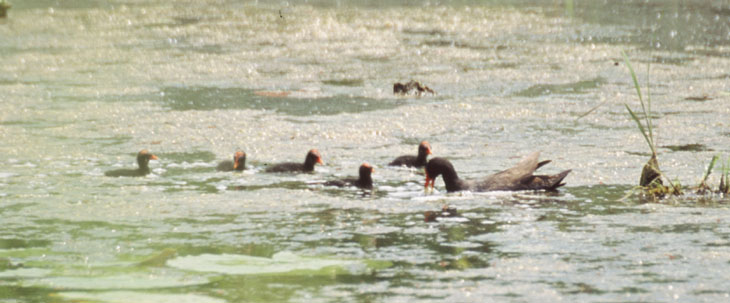
Late in the trip, we ended up going to Hilton Head Island. This wasn’t in the original plans, but our friends treated us in order to coax us to stay a little longer – they felt guilty because of their intrusive work schedule, I think. I normally avoid touristy areas, since I’d rather be farther away from people, but I’m game to explore anyplace once. We had to wait to check into our suite, so we backtracked a little and checked out the refuge we passed on our way onto the island. Pinckney Island National Wildlife Refuge is a small place mostly made up of tidal flats, just a little turnoff between two causeways and not terribly promising in appearance. The path was a gravel road that seemed at first too open and exposed to offer much in the way of viewing opportunities. Not too far along, however, we came across a mudflat area that could have kept me busy for a while.
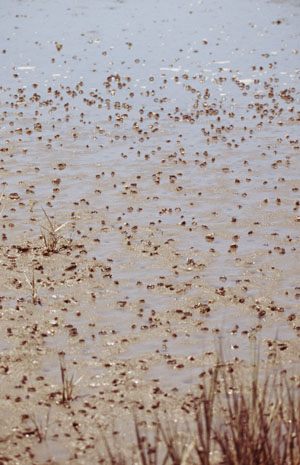 Once again, the fiddler crabs were in evidence, and I don’t say this lightly – it was the largest collection I’ve ever seen. The number of them was so great that one could be excused for imagining they were only stubs of plants or something, and being diminutive and off the trail a short ways, they could be totally missed if someone wasn’t being alert. I suspect I’ve mentioned before that I like crabs, and could have spent no small amount of time right there – I also could have gotten really filthy doing so, trying to get up close to a subject standing not two centimeters tall that liked soft mud. Decorum won out, however, as the patience of my friends and the prospect of getting back into their car covered in black mud prevented me from indulging in my native instincts. I still spent a few minutes chasing them and watching their antics.
Once again, the fiddler crabs were in evidence, and I don’t say this lightly – it was the largest collection I’ve ever seen. The number of them was so great that one could be excused for imagining they were only stubs of plants or something, and being diminutive and off the trail a short ways, they could be totally missed if someone wasn’t being alert. I suspect I’ve mentioned before that I like crabs, and could have spent no small amount of time right there – I also could have gotten really filthy doing so, trying to get up close to a subject standing not two centimeters tall that liked soft mud. Decorum won out, however, as the patience of my friends and the prospect of getting back into their car covered in black mud prevented me from indulging in my native instincts. I still spent a few minutes chasing them and watching their antics.
Male fiddlers have a dominant cheliped (“claw”) that can be either side, but always outweighs its opposite by a wide margin – they earned their common name because they wave this in both warning and mating displays. The species – these were most likely mud fiddlers (Uca pugnax) – live in small holes dug into the sand or soft mud, and feed on little bits of organic matter in the mud, either vegetation or scavenged animal matter and plankton. While they need to keep their breathing apparatus moist, they’re not an aquatic species like a blue crab and can handle being out of the water. The eggs are released into neap tide to be carried away, and the young live on plankton in deeper water, before coming back into tidal zones as adults. Handling them, if you’re quick enough to catch one, is easy, since the chelipeds are rarely large enough to do more than pinch a bit, and mostly they just try to sidle away shyly (unlike the very aggressive aquatic blue crabs, for instance.) They’re also a subject you need very little patience for; scare them into their burrows with an incautious movement, and you only have to wait a minute or two before they venture out again.
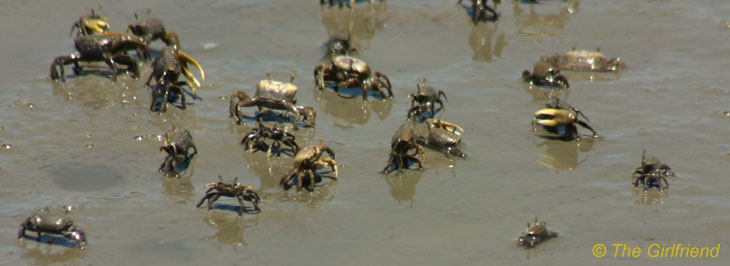
A little further on, we watched a pair of American white ibis (Eudocimus albus) foraging in the same kind of area and tried for some useful compositions, unaware of what waited a little further up the trail. We were just thinking of turning back, partially because of the heat, partially because we hadn’t planned on being in the open so long and hadn’t applied sunscreen, when we came to what I think was identified as “Osprey Pool.” In an earlier post, I enthused about Venice Audubon Society Rookery in Florida, but I’d never heard of Pinckney Island before, and they have their own version. June seems to me to be too late to find nesting birds, especially in warmer southern states, but nobody apparently told the white ibis that – they were nesting in abundance, and much easier to photograph than at Venice as well.
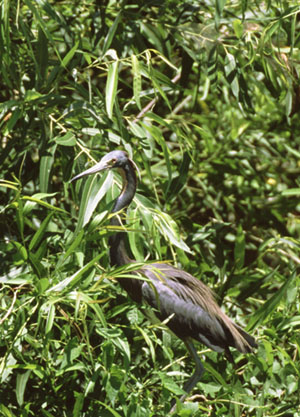 Countless other species were raising their young there too. A couple of fledgling tricolor herons (Egretta tricolor,) seen at right, were flying heavily from perch to perch and making a ridiculous amount of noise, upset because their mother was trying to convince them to find their own food. A few anhinga (Anhinga anhinga) youngsters could be seen, and we spotted double-crested cormorants, great egrets, wood ducks, black-crowned night herons, and at least one example each of little blue and green herons. The activity was constant, one of those situations where you can only look in one direction at a time and thus know you’re missing something in another (that’s why there were three of us shooting.) Since The Girlfriend’s camera was being balky, she used my digital while I shot film, and so she got to be a bit more serious in chasing subjects – it convinced her to invest in her own DSLR now (and will have a significant upgrade over mine.) Among three cameras we have several hundred images, and could have remained there half the day, if we didn’t need water and shade. Next time, it’ll be a picnic lunch, I’m sure. And much earlier in the day.
Countless other species were raising their young there too. A couple of fledgling tricolor herons (Egretta tricolor,) seen at right, were flying heavily from perch to perch and making a ridiculous amount of noise, upset because their mother was trying to convince them to find their own food. A few anhinga (Anhinga anhinga) youngsters could be seen, and we spotted double-crested cormorants, great egrets, wood ducks, black-crowned night herons, and at least one example each of little blue and green herons. The activity was constant, one of those situations where you can only look in one direction at a time and thus know you’re missing something in another (that’s why there were three of us shooting.) Since The Girlfriend’s camera was being balky, she used my digital while I shot film, and so she got to be a bit more serious in chasing subjects – it convinced her to invest in her own DSLR now (and will have a significant upgrade over mine.) Among three cameras we have several hundred images, and could have remained there half the day, if we didn’t need water and shade. Next time, it’ll be a picnic lunch, I’m sure. And much earlier in the day.
The pond was little more than a moat around an island, and I’m not really sure where the fresh water came in. We were never more than a few hundred meters from the tidal flats, though, and an opportunistic alligator was in evidence here, too. It had chosen some duckweed to skulk about within, and had surfaced from underneath rather than swimming into it, resulting in a nice coating across its head, increasing its camouflage – I have no doubts that this is an instinctive habit. While there, it heard a mother gallinule hiding in the reeds of the island, and if I can judge from the different nature of her calls, she knew quite well the gator was there, and was telling the kids to stay close and hidden. We only got the barest glimpse of her and the young in the reeds, but the gator nosed up to the very edge of the water pointed directly at her location, hoping for a snack from an incautious fledgling. Some might consider the gator to be the villain in this scenario, big nasty thing feeding on cute little fluffy thing, but that’s the natural order – the gallinules themselves feed on insects and frogs as well as aquatic plants, and this is no less, or more, cruel. It is merely the food cycle, no emotions involved, and our attempts to pin some kind of value judgment on any of it is inappropriate and misleading. Just observe.
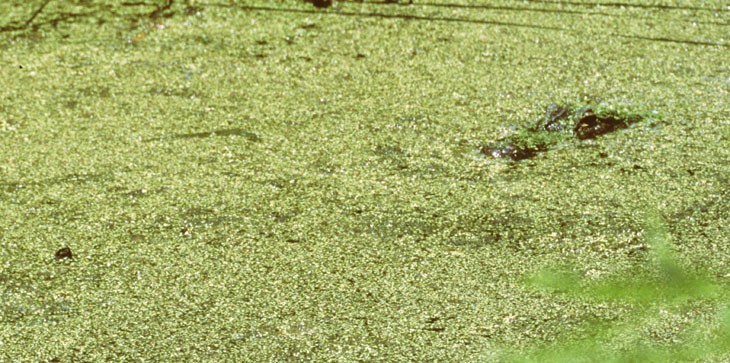
Again, I’m not in a hurry to check out Hilton Head again, being too developed for my tastes, but I will certainly try to return to Pinckney Island and spent a lot more time there. Our visit was longer than intended and far briefer than it warranted, and serious birders and nature photographers should include it in their list of locales. The benefit, of course, is that you can then crash and eat on Hilton Head rather than in a tent someplace ;-)
